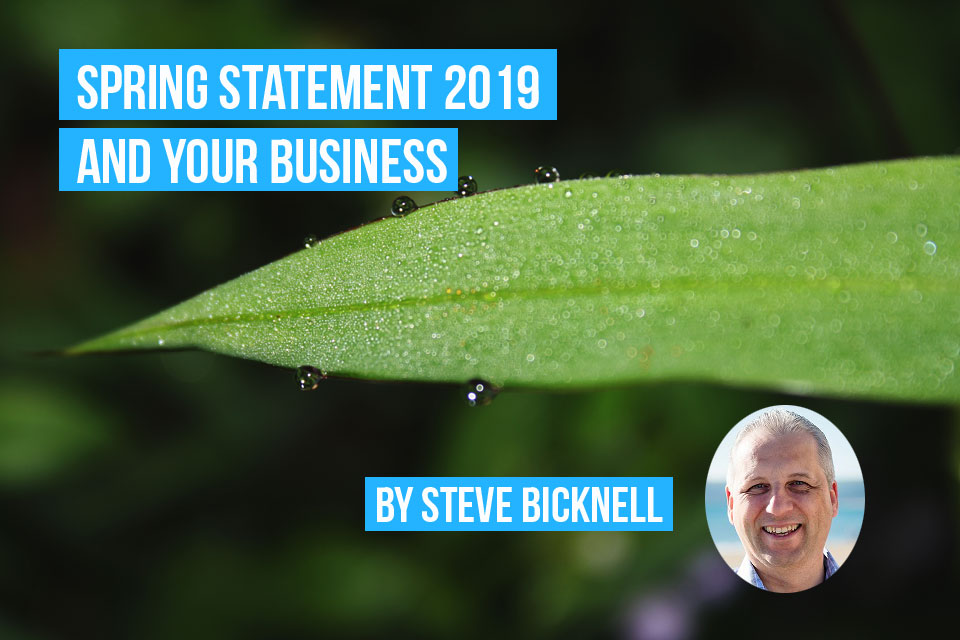With Brexit looming, the impact on the economy is almost palpable. Yet business must continue and so on March 13th, Chancellor Philip Hammond presented the Spring Statement to provide details on measures that could affect UK businesses.
This article breaks down the 2019 Spring Statement and focuses on elements that have the potential to affect UK freelancers, sole traders, and small businesses.

Income Tax
There haven’t been any big changes to the income tax and personal allowance since the Autumn Budget was announced in 2018. The rates announced come into effect April 6th, 2019 and are as follows:
| Tax band in GBP | % |
|---|---|
| 0 - 37,500 | 20 |
| 37,501 - 150,000 | 40 |
| 150,000 and above | 45 |
Note that these bands and rates are for England and Northern Ireland only. The bands and percentages differ for residents of Scotland and Wales.
Income Tax in Scotland
Scottish income and tax rates differ from other parts of the UK. Scottish rates apply to income earned in employment, as well as from property and self-employed trade profits. The rates are:
| Band name | Tax band in GBP | % |
|---|---|---|
| Starter | 0 - 2,049 | 19 |
| Scottish Basic | 2,050 - 12,444 | 20 |
| Intermediate | 12,445 - 30,930 | 21 |
| Higher | 30,931 - 150,000 | 41 |
| Top | 150,000 and above | 46 |
Income Tax in Wales
For Welsh residents, the UK government announced a reduction in each of the three rates of income tax by 10 pence. Because the Welsh government influences the tax rate paid by residents of Wales, the tax rate has been set to 10p. This will be paid directly to the Welsh government, while HMRC will continue to collect tax as usual, so essentially, the final rates themselves do not change.
Making Tax Digital
It’s almost here. After April 1st, VAT-registered businesses over the £85,000 taxable threshold will need to use approved Making Tax Digital software to submit VAT returns online directly to HMRC.
As part of the Spring Statement, Chancellor Hammond addressed several topics regarding MTD. Namely, that for those worried about penalties, HMRC will be taking a light approach in order to help ensure a smooth transition.
Entrepreneurs’ Relief
The major change to Entrepreneurs’ Relief is that the time period during which a business must meet the required conditions has been increased from 1 year to 2 years.
However, an exception to this rule applies to businesses that ceased activity before October 29th, 2018. For these businesses, the original requirement of 1 year meeting the specified conditions still applies.
Current regulations state that businesses that are eligible to qualify for Entrepreneurs’ Relief must be considered a ‘personal company’ - in other words, the person applying must meet the following requirements:
- They must hold at least 5% of the ordinary share capital
- They must be able to exercise at least 5% of the voting rights
- They must be an employee or office holder of the company
However, two additional requirements now apply:
- The applicant must be entitled to a minimum of 5% of the company’s profits and 5% of the value of the assets in the case the business is sold or winding up
Capital allowances
Dealing with capital allowances can get a little complex, however, they’re still important for small businesses to keep an eye on as they can provide added (or reduced) savings when it comes to your Annual Investment Allowance (AIA) and other expenses related to equipment and property.
The Autumn Budget, for example, announced a two year change in the AIA from £200,000 to £1 million. This new allowance is applicable to expenses that qualify and are incurred after January 1st, 2019.
Plants and machinery capital allowance
In the Spring Statement, several changes were announced regarding capital allowances in relation to plants and machinery:
- The writing down allowance (WDA) was reduced from 8% to 6%. This applies to the special rate pool of plant and machinery and is effective from April 2019.
- From April 2020, the end of the 100% first year allowance and tax credit for products on the Water Technology List and Energy Technology List.
The Structures and Buildings Allowance
A new type of capital allowance was also introduced. Named the Structures and Buildings Allowance (SBA), it provides allowance for buildings purchased for commercial use, as well as any renovations or changes to current buildings to put them to use that qualifies for this allowance.
There are, however, some conditions that must be met in order for a building expense to qualify for the SBA:
- Only the original expense qualifies, whether construction or renovation, given across a fixed 50-year period at a flat rate of 2%. Changes in ownership will not have an effect.
- It is only applicable to expenses that are incurred after October 29th, 2018.
The building or structure must be used for commercial purposes in order to qualify.
This allowance was introduced in order to help bridge the gap that has been present since the Industrial and Agricultural Buildings Allowances that was phased out in 2011. The SBA also aims to encourage increased construction of properties for commercial use.
The Spring Statement and your business
If you’re running a small business, some of these new measures could have an impact on your business. If you’re unsure of whether any of these apply, it’s best to find an accountant or financial professional that can help to ensure you’re getting the most out of the allowances available to your business, for example.
The best way to get clear answers is to have current and thorough financial records for your business, to make it easy to see how any of these changes might have an effect. Managing your cash flow can be simple with good accounting & invoicing software like Debitoor.
